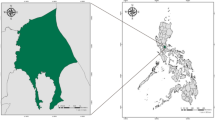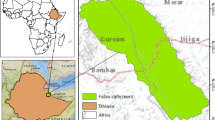Abstract
Considerable land cover changes have occurred in the Luvuvhu catchment in northeastern South Africa in the past two decades. These changes are associated with human population growth and may be contributing to observed reductions in winter river baseflows and increased episodes of river drying within Kruger National Park. Six-class land cover maps of the catchment were created from 1978 (MSS) and 2005 (TM) Landsat imagery using an iterative technique. Results indicate a 1,000 km2 (12%) increase in Bare Ground between 1978 and 2005, with a concomitant decrease in shrubland and indigenous forest cover. Overall classification accuracy in the 2005 image was 80%. Classification was most accurate for Water and Pine classes (100 and 92%) and least accurate for Indigenous Forest (46%), primarily due to misclassification as Shrubland. These maps are suitable for land cover change and landscape modeling analyses, and can serve as baseline data for further research.






Similar content being viewed by others
References
Anderson, J. R., Hardy, E. E., Roach, J. T., & Witmer, R. E. (1976). A landuse and land cover classification system for use with remote sensor data. Geological Survey Prof. Paper 964. Washington DC, USA: USDA. US Government Printing Office.
Arnold, J. G., Srinivasan, R., Muttiah, R. S., & Williams, J. R. (1998). Large area hydrologic modeling and assessment; part I: model development. Journal of the American Water Resources Association, 34, 73–89.
Baldyga, T. J., Miller, S. N., Driese, K. L., & Maina Gichaba, C. (2007). Land cover change assessment within Kenya’s Mau forest region using remotely sensed data. African Journal of Ecology, doi: 10.1111/j.1365-2028.2007.00806.x.
Bierregaard, R. O., Lovejoy, T. E., Kapos, V., dos Santos, A. A., & Hutchings, R. W. (1992). The biological dynamics of tropical rainforest fragments. Bioscience, 42, 859–866.
Bonell, M. (2004). Selected issues in mountain hydrology of the humid tropics. IHP-VI technical document in hydrology No. 70. UNESCO Working series SC-2004/WS/51.
Brooks, K. N., Ffolliott, P. F., Gregersen, H. M., & DeBano, L. F. (2003). Hydrology and the management of watersheds (3rd ed.). Ames, Iowa: Iowa State Press.
Bruijnzeel, L. A. (2004). Hydrologicalal functions of tropical forests: Not seeing the soil for the trees? Agriculture. Ecosystems & Environment, 104, 185–228.
Calder, I. R. (1993). Hydrological effects of land-use change. Pages 13.1–13.50 in D.R. Maidment, editor. USA: Handbook of hydrology. McGraw-Hill, Inc.
Congalton, R. G., & Green, K. (1999). Assessing the accuracy of remotely sensed data: principles and practices (pp. 45–48). Boca Raton, Florida: CRC Press.
Cousins, B. (1999). Invisible capital: the contribution of communal rangelands to rural livelihoods in South Africa. Development South Africa, 16, 299–319.
Department of Water Affairs and Forestry (DWAF). (2004). Internal strategic perspective: Luvuvhu/Letaba water management area. Prepared by Goba Moahloli Keeve Steyn (Pty) Ltd for the South African Department of Water Affairs and Forestry (Report No. PWMA 02/000/00/0304).
ESRI. (2004). ArcGIS Version 9.0 Software. Redlands, CA: Environmental Systems Research Institute.
FAO & ISRIC. (2003). Soil and Terrain database for Southern Africa (SOTERSAF). Land and Water Digital Media Series No. 25, FAO, Rome.
Griscom, H. R. (2007). The Drying of the Luvuvhu River, South Africa; Distinguishing the Roles of Dams and Land Cover Change, M.S. Thesis, Department of Renewable Resources, 65 pp.
Higgins, S. I., Shackleton, C. M., & Robinson, R. E. (1999). Changes in woody community structure and composition under contrasting landuse systems in a semi-arid savanna, South Africa. Journal of Biogeography, 26, 619–627.
Hope, R. A., Jewitt, G. P. W., & Gowing, J. W. (2004). Linking the hydrologicalal cycle and rural livelihoods: a case study in the Luvuvhu catchment, South Africa. Physics and Chemistry of the Earth, 29, 1209–1217.
Hudson, P. F., Colditz, R. R., & Aguilar-Robledo, M. (2006). Spatial relations between floodplain environments and land use–land cover of a large lowland tropical river valley: Panuco basin, Mexico. Environmental Management, 38, 487–503.
Hudson, W. D., & Ramm, C. W. (1987). Correct formulation of the kappa coefficient of agreement. Photogrammetric Engineering and Remote Sensing, 53, 421–422.
International Union of Soil Scientists Working GroupWRB (IUSS). (2006). World reference base for soil resources 2006. (2nd ed.). World Soil Resources Reports No. 103. FAO, Rome.
Jensen, J. R.(2005). Introductory digital image processing: A remote sensing perspective. Upper Saddle River, NJ: Prentice-Hall.
Jensen, J. R., Ramsey, E. W., Mackey, H. E., Christensen, E. J., & Sharitz, R. R. (1987). Inland wetland change detection using aircraft MSS data. Photogrammetric Engineering and Remote Sensing, 53, 521–529.
Jewitt, G. P. W., Garratt, J. A., Calder, I. R., & Fuller, L. (2004). Water resources planning and modeling tools for the assessment of land use change in the Luvuvhu Catchment, South Africa. Physics and Chemistry of the Earth, 29, 1233–1241.
Kayombo, B., & Lal, R. (1993). Tillage systems and soil compaction in Africa. Soil & Tillage Research, 27, 35–72.
Kleynhans, C. L. (1996). A qualitative procedure for the assessment of the habitat integrity status of the Luvuvhu River (Limpopo system, South Africa). Journal of Aquatic Ecosystem Health, 5, 41–54.
Kuplich, T. M. (2006). Classifying regenerating forest stages in Amazonia using remotely sensed images and a neural network. Forest Ecology and Management, 234, 1–9.
Landis, J., & Koch, G. (1977). The measurement of observer agreement for categorical data. Biometrics, 33, 159–174.
Lane, P. N. J., Best, A. E., Hickel, K., & Zhang, L. (2005). The response of flow duration curves to afforestation. Journal of Hydrology, 310, 253–265.
Miller, S. N., Kepner, W. G., Mehaffey, M. H., Hernandez, M., Miller, R. C., Goodrich, D. C., et al. (2002). Integrating landscape assessment and hydrological modeling for land cover change analysis. Journal of the American Water Resources Association, 38, 915–929.
Miller, S. N., Semmens, D. J., Goodrich, D. C., Hernandez, M., Miller, R. C., Kepner, W. G., et al. (2007). The automated geospatial watershed assessment tool. Environmental Modelling & Software, 22(3), 365–377.
O’Keeffe, J., & Davies, B. (1991). Conservation and management of the rivers of Kruger National Park: Suggested methods for calculating instream flow needs. Aquatic Conservation: Marine and Freshwater Ecosystems, 1, 55–71.
Powers, J. S., Read, J. M., Denslow, J. S., & Guzman, S. M. (2004). Estimating soil carbon fluxes following land-cover change: A test of some critical assumptions for a region in Costa Rica. Global Change Biology, 10, 170–181.
Schulze, R. E. (2000). Modelling hydrological responses to land use and climate change: A Southern African perspective. Ambio, 29, 12–22.
Shackleton, C. M., Guthrie, G., & Main, R. (2005). Estimating the potential role of commercial over-harvesting in resource viability: A case study of five useful tree species in South Africa. Land Degradation & Development, 16, 273–286.
Sivanpillai, R., & Latchininsky, A. V. (2007). Mapping locust habitats in the Amudarya River Delta, Uzbekistan with multi-temporal MODIS imagery. Environmental Management, 39, 876–886.
Sivanpillai, R., & Miller, S. N. (2008). Benefits of pan-sharpened Landsat imagery for mapping small water bodies in the Powder River Basin, Wyoming, USA. Lakes & Reservoirs: Research and Management, 13(1), 69–76.
Sivanpillai, R., Smith, C. T., Srinivasan, R., Messina, M. G., & Wu, X. B. (2005). Estimating regional forest cover in east Texas using ETM + imagery. Forest Ecology and Management, 218, 342–352.
Tinley, K. L. (1977). The Northern Kruger National Park—An ecological inventory prepared for the Wildlife Society. African Wildlife (special issue 1).
U.S. EPA. (1993). North American Landscape Characterization (NALC) Research Brief. EPA/600/S-93/0005, Office of Research and Development (pp. 8). Washington, D.C.
Van der Waal, B. C. W. (1997). Fundudzi, a unique, sacred and unknown South African lake. South African Journal of Aquatic Science, 23, 42–55.
Van Lill, W. S., Kruger, F. J., & Van Wyk, D. B. (1980). The effect of afforestation with Eucalyptus grandis Hill ex maiden and Pinus patula Schlecht et cham. on streamflow from experimental catchments at Mokobulaan, Transvaal. Journal of Hydrology, 48, 107–118.
Van Wyk, D. B. (1987). Some effects of afforestation on streamflow in the Western Cape Province, South Africa. Water S.A., 13, 31–36.
Water Research Commission (WRC). (2001). State of Rivers Report: Letaba and Luvuvhu river systems -2001. WRC report no. TT165/01. Pretoria: Water Research Commission.
Wayman, J. P., Wynne, R. H., Scrivani, J. A., & Reams, G. R. (2001). Landsat TM-based forest area estimation using iterative guided spectral class rejection. Photogrammetric Engineering and Remote Sensing, 67, 1155–1165.
Yemefack, M., Bijker, W., & De Jong, S. M. (2006). Investigating relationships between Landsat-7 ETM + data and spatial segregation of LULC types under shifting agriculture in southern Cameroon. International Journal of Applied Earth Observation and Geoinformation, 8, 96–112.
Web References
Brandl, G. (2006). “Geology”, A first synthesis of the environmental, biological & cultural assets of the Soutpansberg. Institute of Conservation and Natural History of the Soutpansberg. Accessed November 19, 2006, Soutpansberg, Limpopo Biosphere Initiative http://www.soutpansberg.com/workshop/synthesis/geology.htm.
United States Geological Survey (USGS). (2006). National Land Cover Dataset 1992 (NLCD 1992). The USGS Land Cover Institute (LCI). Accessed November, 2006, Updated March 2006. http://landcover.usgs.gov/natllandcover.php.
Acknowledgments
We gratefully acknowledge primary funding support from the Wyoming NASA Space Grant Consortium and Wyoming NASA EPSCoR (NASA Grant #NGT-40102 40102 and #NCC5-578). Other financial support was provided by the University of Wyoming’s International Programs, Haub School of Environment and Natural Resources, Department of Renewable Resources, and the Wyoming and National Garden Clubs, Inc. Thanks to Patrick Xibambu, Thomas Mbokota, Kruger National Park Ranger for field support. GIS support generously provided by Sandra Mac Fadyen, Kruger National Park GIS and Remote Sensing Analyst.
Author information
Authors and Affiliations
Corresponding author
Rights and permissions
About this article
Cite this article
Griscom, H.R., Miller, S.N., Gyedu-Ababio, T. et al. Mapping land cover change of the Luvuvhu catchment, South Africa for environmental modelling. GeoJournal 75, 163–173 (2010). https://doi.org/10.1007/s10708-009-9281-x
Received:
Accepted:
Published:
Issue Date:
DOI: https://doi.org/10.1007/s10708-009-9281-x




